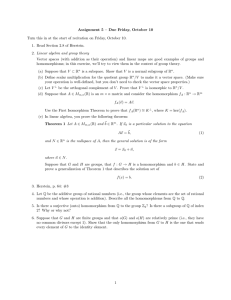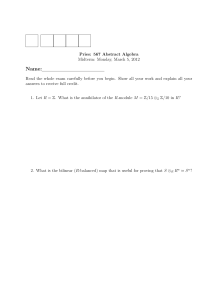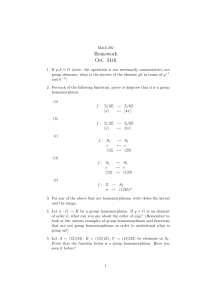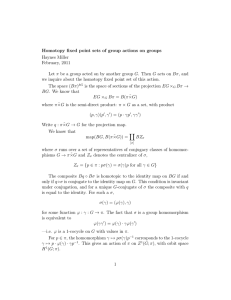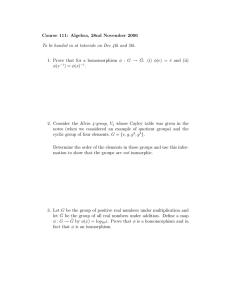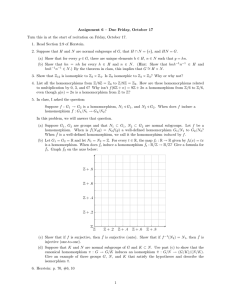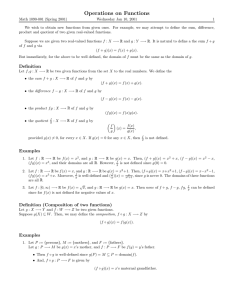Solutions to Assignment 6 #2
advertisement
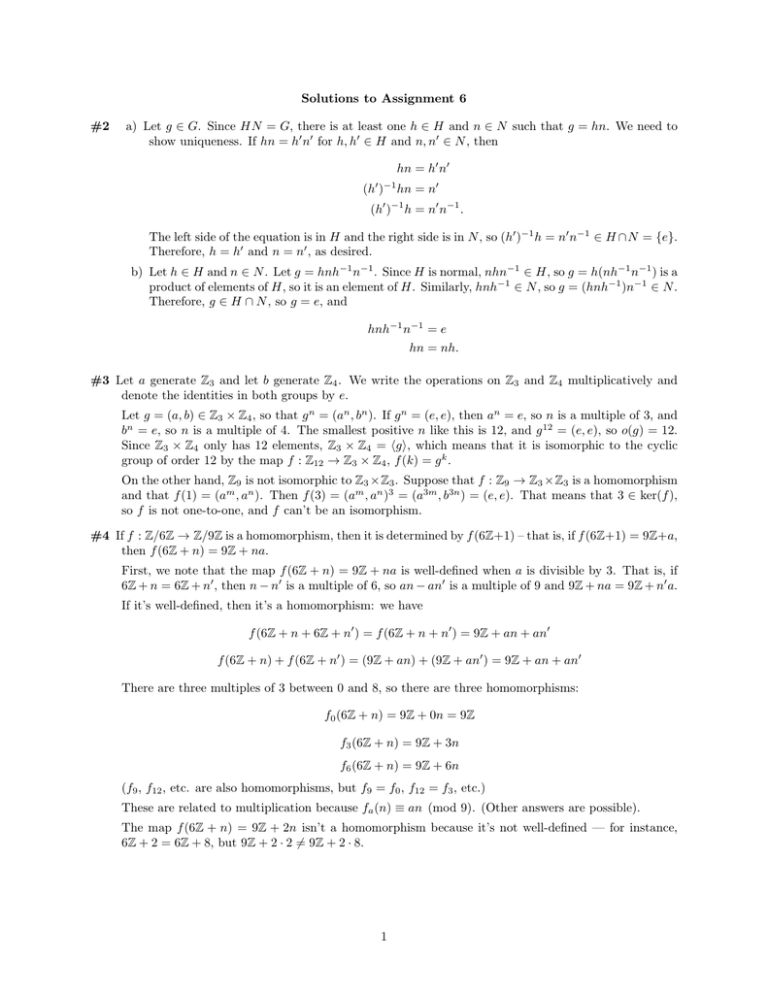
Solutions to Assignment 6
#2
a) Let g ∈ G. Since HN = G, there is at least one h ∈ H and n ∈ N such that g = hn. We need to
show uniqueness. If hn = h0 n0 for h, h0 ∈ H and n, n0 ∈ N , then
hn = h0 n0
(h0 )−1 hn = n0
(h0 )−1 h = n0 n−1 .
The left side of the equation is in H and the right side is in N , so (h0 )−1 h = n0 n−1 ∈ H ∩N = {e}.
Therefore, h = h0 and n = n0 , as desired.
b) Let h ∈ H and n ∈ N . Let g = hnh−1 n−1 . Since H is normal, nhn−1 ∈ H, so g = h(nh−1 n−1 ) is a
product of elements of H, so it is an element of H. Similarly, hnh−1 ∈ N , so g = (hnh−1 )n−1 ∈ N .
Therefore, g ∈ H ∩ N , so g = e, and
hnh−1 n−1 = e
hn = nh.
#3 Let a generate Z3 and let b generate Z4 . We write the operations on Z3 and Z4 multiplicatively and
denote the identities in both groups by e.
Let g = (a, b) ∈ Z3 × Z4 , so that g n = (an , bn ). If g n = (e, e), then an = e, so n is a multiple of 3, and
bn = e, so n is a multiple of 4. The smallest positive n like this is 12, and g 12 = (e, e), so o(g) = 12.
Since Z3 × Z4 only has 12 elements, Z3 × Z4 = hgi, which means that it is isomorphic to the cyclic
group of order 12 by the map f : Z12 → Z3 × Z4 , f (k) = g k .
On the other hand, Z9 is not isomorphic to Z3 ×Z3 . Suppose that f : Z9 → Z3 ×Z3 is a homomorphism
and that f (1) = (am , an ). Then f (3) = (am , an )3 = (a3m , b3n ) = (e, e). That means that 3 ∈ ker(f ),
so f is not one-to-one, and f can’t be an isomorphism.
#4 If f : Z/6Z → Z/9Z is a homomorphism, then it is determined by f (6Z+1) – that is, if f (6Z+1) = 9Z+a,
then f (6Z + n) = 9Z + na.
First, we note that the map f (6Z + n) = 9Z + na is well-defined when a is divisible by 3. That is, if
6Z + n = 6Z + n0 , then n − n0 is a multiple of 6, so an − an0 is a multiple of 9 and 9Z + na = 9Z + n0 a.
If it’s well-defined, then it’s a homomorphism: we have
f (6Z + n + 6Z + n0 ) = f (6Z + n + n0 ) = 9Z + an + an0
f (6Z + n) + f (6Z + n0 ) = (9Z + an) + (9Z + an0 ) = 9Z + an + an0
There are three multiples of 3 between 0 and 8, so there are three homomorphisms:
f0 (6Z + n) = 9Z + 0n = 9Z
f3 (6Z + n) = 9Z + 3n
f6 (6Z + n) = 9Z + 6n
(f9 , f12 , etc. are also homomorphisms, but f9 = f0 , f12 = f3 , etc.)
These are related to multiplication because fa (n) ≡ an (mod 9). (Other answers are possible).
The map f (6Z + n) = 9Z + 2n isn’t a homomorphism because it’s not well-defined — for instance,
6Z + 2 = 6Z + 8, but 9Z + 2 · 2 6= 9Z + 2 · 8.
1
#5
a) Suppose that f (N1 ) ⊂ N2 and suppose that N1 g = N1 g 0 . To show that f¯ is well-defined, we have
to show that N2 f (g) = N2 f (g 0 ). But g 0 g −1 ∈ N1 , so
f (g 0 g −1 ) = f (g 0 )f (g −1 ) ∈ N2 ,
which implies that N2 f (g) = N2 f (g 0 ), so f¯ is well-defined.
On the other hand, suppose that f¯ is well-defined. Then
f¯(N1 ) = f¯(N1 e) = N2 f (e) = N2 .
When g ∈ N1 , then on one hand we have
f¯(N1 g) = N2 f (g).
On the other hand, N1 g = N1 , so
f¯(N1 g) = N2 ,
so N2 = N2 f (g) and f (g) ∈ N2 . This implies f (N1 ) ⊂ N2 . So f¯ is well-defined if and only if
f (N1 ) ⊂ N2 .
b) By the previous part, ft induces a homomorphism from R/Z to R/Z if and only if ft (Z) ⊂ Z. This
happens exactly when t ∈ Z, and the resulting map is f¯t (Z + x) = Z + tx. We have Z + tx = Z if
and only if tx ∈ Z, so
ker(f¯t ) = {Z + k/t | k ∈ Z}.
The graph of f¯2 (with a few points labeled) is:
(Z + .4, Z + .8)
Z + .8
Z + .6
(Z + .75, Z + .5)
(Z + .2, Z + .4)
Z + .4
Z + .2
Z
Z
Z + .2
Z + .4
Z + .6
Z + .8
c) Suppose that f is surjective and let h ∈ G2 . We claim that there is some g ∈ G1 such that
f¯(N1 g) = N2 h. Let g ∈ f −1 (h); since f is surjective, this inverse image is nonempty. By the
definition of f¯, we have f¯(N1 g) = N2 h.
On the other hand, suppose that f −1 (N2 ) = N1 . We claim that if f¯(N1 g) = f¯(N1 g 0 ), then
N1 g = N1 g 0 . We have:
f¯(N1 g) = f¯(N1 g 0 )
N2 f (g) = N2 f (g 0 )
f (g)f (g 0 )−1 ∈ N2
f (g(g 0 )−1 ) ∈ N2
g(g 0 )−1 ∈ f −1 (N2 ) = N1
N1 g = N1 g 0 .
as desired.
2
d) Let π : G → G/K be the canonical homomorphism. Then N ⊂ G is a normal subgroup and
N/K ⊂ G/K is a normal subgroup (by the Correspondence Theorem). So we apply part (a) with
G1 = G, N1 = N , G2 = G/K, N2 = N/K. Since π(N ) = N/K, π induces a map
π̄ : G/N → (G/K)/(N/K).
By part (c), this map is injective and surjective, so it is an isomorphism.
For example, suppose that G = Z, N = 2Z, and K = 6Z. Then N / G, K / G, and K ⊂ N . We
have
G/N = Z/2Z ∼
= Z2 = {2Z, 2Z + 1}
G/K = Z/6Z ∼
= Z6 = {6Z, 6Z + 1, . . . , 6Z + 5}
∼ Z3 = {6Z, 6Z + 2, 6Z + 4}.
N/K = 2Z/6Z =
The quotient (G/K)/(N/K) consists of two cosets, N/K and N/K + 1. The map π̄ : G/N →
(G/K)/(N/K) sends 2Z to N/K = {6Z, 6Z + 2, 6Z + 4} and sends 2Z + 1 to N/K + 1 =
{6Z + 1, 6Z + 3, 6Z + 5}.
p. 70, #6 Note that for every x ∈ G, x2 = e and that the product of any two non-identity elements is
the third non-identity element. These two properties and the fact that e is the identity completely
determine the multiplication table of G. So any map that sends e to e and permutes a, b, and ab is an
automorphism of G. There are six such maps, corresponding to the six permutations of {a, b, ab}. (We
haven’t discussed this in class yet, but the automorphism group is S3 , the symmetric group on three
elements.)
p. 70, #10 G a finite group, T an automorphism such that T (x) = x iff x = e. Show that every g ∈ G can
be written as x−1 T (x).
Consider the map (not necessarily a homomorphism) f : G → G given by f (x) = x−1 T (x). Since G is
a finite group, f is a bijection if and only if it is one-to-one if and only if it is onto, so it is enough to
show that f is one-to-one. Suppose that x, y ∈ G and f (x) = f (y). Then
x−1 T (x) = y −1 T (y)
yx−1 = T (y)T (x)−1
yx−1 = T (yx−1 ).
By our assumption on T , this implies that yx−1 = e, so y = x, and the map is one-to-one.
3
